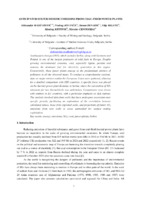Претрага
6 items
-
Effects of Energy Production and Consumption on Air Pollution in Serbia
Marija Živković (2019)Energy production and combustion, mostly from unregulated or inefficient fuel combustion, are the single most important anthropogenic sources of air pollutant emissions. Energy sector in Serbia is highly fossil fuel intensive: 87.88% of energy consumed in Serbia is related to fossil fuels, while almost 95% of energy sources are combusted. In 2017. energy related carbon dioxide emission in Serbia is was 47.95 million tones. The main source of carbon dioxide emission was coal, responsible for almost 70% of energy ...Marija Živković. "Effects of Energy Production and Consumption on Air Pollution in Serbia" in Mining and Environmental Protection-MEP 2019, University of Belgrade, Faculty of Mining and Geology (2019) М31
-
Analysis of the exhaust emissions inventory from auxiliary mining machines
Stevan Đenadić, Aleksandar Mirković, Jovana Mitrović, Filip Miletić, Predrag Jovančić, Dragan Ignjatović (2023)Open-pit coal mines are equipped with a large number of mining machines and vehicles with diesel engines. Due to common daily operation of these machines and vehicles large amounts of exhaust gases which contain numerous pollutants are emitted into the atmosphere. The demand to reduce air pollution induced the activities in developed countries to map and calculate all gases emitted by industries to formulate and select adequate preventive activities. In collaboration with machine manufacturers, emission standards for off-road machines ...Stevan Đenadić, Aleksandar Mirković, Jovana Mitrović, Filip Miletić, Predrag Jovančić, Dragan Ignjatović. "Analysis of the exhaust emissions inventory from auxiliary mining machines" in 9th International Conference Mining and Environmental Protection, University of Belgrade, Faculty of Mining and Geology (2023) М33
-
Projection of SO2 emissions in coal power plants in Serbia
Aleksandar Madžarević, Predrag Jovančić, Stevan Đenadić, Filip Miletić, Miodrag Ristović, Miroslav Crnogorac (2023)The production of electricity in the countries of South-Eastern Europe (SEE) was mainly related to the use of coal, predominantly lignite. The total installed capacity of thermal power plants using coal in these seven countries is 17.813 MW, distributed in 31 thermoblocks. The mentioned plants are the dominant pollutant emitters in all observed countries. Data on the largest emitters in the countries of the European Union and a comparison with SEE countries were collected. The calculation of emissions of ...Aleksandar Madžarević, Predrag Jovančić, Stevan Đenadić, Filip Miletić, Miodrag Ristović, Miroslav Crnogorac. "Projection of SO2 emissions in coal power plants in Serbia" in 9th International Conference Mining and environmental protection, Sokobanja 24-27th May 2023., Belgrade : University of Belgrade, Faculty of Mining and Geology (2023) М33
-
Anticipated sulfur dioxide emissions from coal-fired power plants
Aleksandar Madžarevic, Predrag Jovančić, Stevan Đenadić, Filip Miletić, Miodrag Ristović, Miroslav Crnogorac (2024)Southeastern Europe (SEE), which includes Serbia, along with Germany and Poland, is one of the largest producers of solid fuels in Europe. Despite growing environmental concerns, coal, especially lignite, persists and remains the dominant fuel for electricity generation in this region. Concurrently, these power plants emerge as the predominant emitters of pollutants in all the observed states. To conduct a comprehensive analysis, data on major emitters within the European Union were gathered, allowing for a detailed comparison with SEE ...Aleksandar Madžarevic, Predrag Jovančić, Stevan Đenadić, Filip Miletić, Miodrag Ristović, Miroslav Crnogorac. "Anticipated sulfur dioxide emissions from coal-fired power plants" in Thermal Science, National Library of Serbia (2024). https://doi.org/10.2298/TSCI240308167M М23
-
Integrative GHG Assessment in Oil and Gas Industry
Reducing greenhouse gas emissions is one of the main targets of national strategies in European countries. As a main contributor to emissions, the energy sector is recognized as the most promising to apply measures and actions aimed to decrease GHG emissions. The Oil and Gas industry as a significant contributor to global greenhouse gas emissions is facing a growing need for estimating, mitigating, and reducing the impact of their operations on the atmosphere to stay competitive in a newly ...Aleksandar Mirković, Marija Živković, Stevan Đenadić, Darja Lubarda, Chinedu Anyanwa. "Integrative GHG Assessment in Oil and Gas Industry" in Energija, ekonomija, ekologija (2023). https://doi.org/10.46793/EEE23-1.51M М51
-
Transition pathways of household heating in Serbia: Analysis based on an agent-based model
To explore pathways of the energy transition of household heating, an agent-based simulation model was developed for the case of the Serbian household sector. The model is focused on individual entities (households) with the objective to explore the effects of policy instruments on energy transition in households with individual heating systems. Empirically collected survey data were used as input for households’ attitudes towards sustainable heating. Simulations showed that the proposed instruments would lead to higher heating efficiency and less ...energetska tranzicija, modeliranje bazirano na agentima, sistemi grejanja, sektor domaćinstva, obnovljivi izvori energije, emisija CO2Boban Pavlović, Dejan Ivezić, Marija Živković. "Transition pathways of household heating in Serbia: Analysis based on an agent-based model" in Renewable and Sustainable Energy Reviews, Elsevier BV (2022). https://doi.org/10.1016/j.rser.2022.112506 М21а




